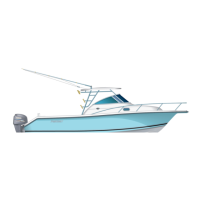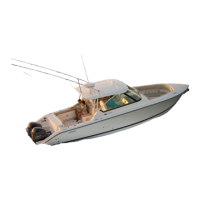Do you have a question about the PURSUIT 2670 CUDDY CONSOLE and is the answer not in the manual?
Defines DANGER, WARNING, CAUTION, and NOTICE statements for safety instructions.
Section to record boat, engine, transmission, and trailer details for service.
Details on warranty, registration cards, product changes, and warranty transfer.
Covers registration, insurance, accident reporting, and operator education.
Overview of the propulsion system, engine types, and basic operation.
Discusses marine growth and galvanic corrosion prevention for outboard motors.
Explains lubrication for 2-cycle and 4-cycle outboard motors.
Details how outboard engines are raw water cooled and system checks.
Explains propeller identification, selection based on application, and maintenance.
Describes gauges like tachometer, speedometer, temperature, and alarms.
Introduces helm controls: throttle, steering, and trim tab systems.
Explains operation of binnacle-style throttle and shift controls.
Details the function and periodic testing of the neutral safety switch.
Explains the use and operation of power tilt and trim features.
Describes the engine stop switch and lanyard safety feature.
Explains the hydraulic steering system components and operation.
Details the function and operation of trim tabs for hull attitude control.
Covers maintenance for control systems, including steering and trim tabs.
Covers fuel system design, safety, fuel withdrawal tubes, and gauges.
Explains the dual tank system, fuel valves, and anti-siphon features.
Provides detailed procedures and safety precautions for fueling the boat.
Covers maintenance of fuel filters, hoses, and fuel quality considerations.
Introduces the 12V DC and AC electrical systems and battery types.
Details the 12V battery setup, TABS, and accessory switch panels.
Explains shore power connection, AC panel, and safety for the AC system.
Covers maintenance for both 12V DC and AC electrical systems and components.
Describes the components of the freshwater system.
Details how to fill, prime, and operate the freshwater system.
Covers routine maintenance tasks for the freshwater system.
Introduces the raw water system and priming procedures.
Explains the operation and maintenance of the washdown system.
Details the livewell system operation and maintenance.
Covers routine maintenance for the raw water system components.
Explains how water is drained overboard via thru-hull fittings.
Describes the cockpit scupper drains and their operation.
Details the drain holes in the T-top legs.
Covers the bilge pump systems and their operation.
Explains drainage for fishboxes and storage compartments.
Describes drainage for exterior sinks and livewells.
Details the drain for the rope locker.
Outlines periodic maintenance for drainage systems.
Discusses ventilation for the cabin via deck hatch and door.
Covers CO hazards, detection, and ventilation practices.
Details maintenance for ventilation components like hinges and acrylic glass.
Covers deck hardware, bow pulpit, anchor, and rope locker.
Describes hull features like swim platform and access plates.
Details cockpit layout, leaning post, tackle storage, and transom door.
Explains helm and electronics locker, cooler, and storage compartments.
Explains the electric marine head, holding tank, and discharge pump.
Details the cabin CO monitor and its function.
Describes access, storage, and amenities in the cabin and V-berth.
Introduces safety equipment and its importance.
Explains engine alarms and actions to take when they sound.
Discusses the neutral safety switch and its testing.
Describes the engine stop switch and its lanyard safety feature.
Lists equipment required by the U.S. Coast Guard.
Details the function and hazards related to CO detectors.
Emphasizes operator responsibility for first aid and preparedness.
Suggests optional safety equipment like EPIRBs and VHF radios.
Outlines general operation, pre-cruise checks, and safety.
Covers basic navigation rules for safe boating.
Lists essential checks before starting engines and departing.
Details procedures for operating the boat and post-operation checks.
Provides safety precautions for operating from the tower helm.
Discusses operator awareness and safety during fishing.
Advises on procedures for grounded vessels and towing.
Covers safe practices for trailering the boat, including vehicle and trailer selection.
Details hull cleaning, bottom painting, zincs, gelcoat, and hardware care.
Covers cleaning and maintenance for vinyl, canvas, and enclosures.
Provides guidance on cleaning the boat's cabin interior.
Explains how to keep the bilge clean and maintain bilge pumps.
Outlines periodic maintenance for various drainage systems.
Guides on preparing the boat for storage and lifting procedures.
Details winterization procedures for freshwater, raw water, and other systems.
Covers reactivation steps after storage and before launching.
Diagram of the boat's 12-volt DC electrical system.
Diagram of the boat's AC electrical system.
Schematic showing the engine control cable routing.
Schematic of the boat's hydraulic steering system.
Diagrams for 2-stroke and 4-stroke fuel systems and selector valves.
Diagrams for freshwater and raw water systems.
Diagrams for hull and cockpit drainage systems.
Illustrates sling positions for lifting and bunk locations for trailers.
Defines nautical terms used throughout the manual.
A template for recording maintenance history and repairs.
Provides the official form for reporting boating accidents.
| Person Capacity | 10 |
|---|---|
| Length Overall (LOA) | 26 ft. 7 in. |
| Length Overall | 26' 7" |
| Draft (hull) | 20 in. |
| Draft | 2' 1" |

